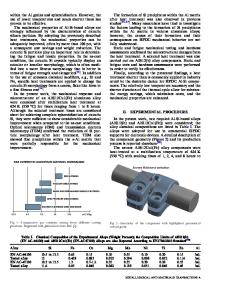Size Effect on Magnesium Alloy Castings
- PDF / 5,303,845 Bytes
- 19 Pages / 593.972 x 792 pts Page_size
- 85 Downloads / 360 Views
ON
MAGNESIUM alloy castings are increasingly used in cyclically loaded structural applications for light weight and better performance.[1] The increasing use of cast magnesium components under cyclic loading has drawn considerable interest in their fatigue properties and fracture behavior.[2–5] It is generally accepted that both casting defects (such as porosity, oxide films, and inclusions)[6–15] and microstructural characteristics (such as grain size, second-phase particles, solid solution matrix, and precipitates)[16–24] dominate fatigue strength and life, crack initiation and propagation behaviors, and deformation mechanism of cast alloys. For magnesium alloy castings, most of fatigue cracks mainly originated from the casting flaws near or close to the free surface during fatigue test.[8–10] The fatigue life of these alloys is determined by the size of the maximum casting flaw.[8–15] In the absence of casting defects or when the casting defect is smaller than a critical size,[11] fatigue failure of cast magnesium alloys is controlled by crack initiation first in a grain that is located at surface or subsurface and crack propagation from either twin grain boundaries (T4-treated condition) and persistence slip ZHENMING LI, Postdoctor, PENG ZHANG, Ph.D. Student, and LIMING PENG, Professor, are with the National Engineering Research Center of Light Alloys Net Forming and State Key Laboratory of Metal Matrix Composite, Shanghai Jiao Tong University, Shanghai 200240, P.R. China. Contact e-mail: [email protected] QIGUI WANG, Professor, Global Powertrain Engineer, is with General Motors Company, Powertrain, Pontiac, MI 48340. ALAN A. LUO, Professor, is with the Ohio State University, Columbus, OH 43210. Manuscript submitted November 8, 2015. Article published online March 22, 2016 2686—VOLUME 47A, JUNE 2016
bands (T6-treated condition).[25] As a recently developed magnesium alloy, Mg-Nd-Zn-Zr (NZK) with higher tensile properties and fatigue performance as well as corrosion resistance is very attractive for power-train and structural application.[10,11,17,19,20,25–31] As an example, it has been reported that the fatigue performances of cast NZK (Mg-Nd-Zn-Zr) magnesium alloys mainly depend on the addition of Zr and Nd elements and application of solid solution and aging treatments.[17,19,20] For a new cast product design, it is desired to have a good capability in predicting the fatigue performance of the designed part instead of physically carrying out testing which is often very costly and time consuming (like high-cycle fatigue testing). Recently, research on cast magnesium alloys without defects[32] has suggested that the fatigue strength of these alloys (such as NZK) can be predicted simply based on tensile properties and hardness. In addition, it is also reported that the multi-scale fatigue (MSF) life models[33] together with characteristic microstructure constituent (grain sizes) can be used to estimate the fatigue life of defect-free magnesium alloys.[25] Based on the tensile properties and grain sizes of the alloy
Data Loading...











